| Columns Retired Columns & Blogs |
Linn Klimax Kontrol preamplifier & Klimax Twin power amplifier Measurements part 2
I looked at the Linn's S/N ratio with the unbalanced inputs selected and shorted. (Because the balanced input offers 6dB lower gain, this should result in S/N ratios 6dB better.) Referenced to 1W into 8 ohms, S/N measured a good 95.4dB when A-weighted, worsening slightly to 93dB with an unweighted audioband measurement. Widening the bandwidth to 500kHz reduced the S/N ratio to 79.5dB, apparently due to the presence of some very-high-frequency noise.
Fig.10 shows the percentage of THD+noise present in the Klimax Twin's output, plotted against frequency at a 2.83V output level. This is low overall, but shows some variation with frequency, which is unusual (other than the slight lift above the audioband, which is due to the normal gain-bandwidth-product limitation). As revealed by figs.11 and 12, however, the spectrum of that distortion is complex, with some high-order harmonics present and the fourth being the highest in level, which is also unusual.
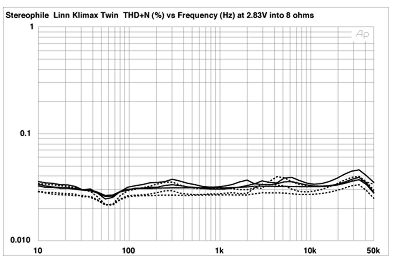
Fig.10 Linn Klimax Twin, unbalanced THD+N (%) vs frequency (from bottom to top at 4kHz): 2.83V into 8 ohms, 4 ohms, 2 ohms, simulated loudspeaker load.
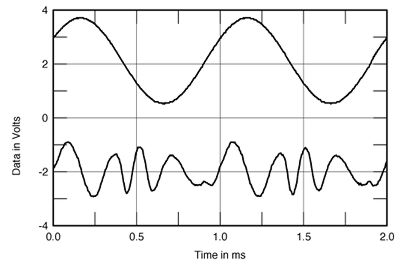
Fig.11 Linn Klimax Twin, 1kHz waveform at 43.7W into 4 ohms (top), 0.032% THD+N; distortion and noise waveform with fundamental notched out (bottom, not to scale).
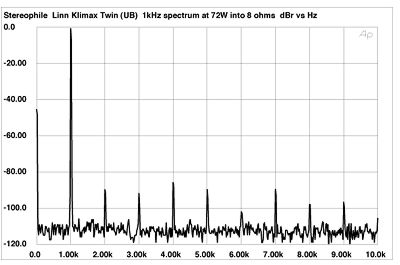
Fig.12 Linn Klimax Twin, unbalanced spectrum of 1kHz sinewave, DC-10kHz, at 72W into 8 ohms (linear frequency scale).
Unusual, too, is that the spectrum of the distortion varied with frequency: the low frequencies were cleaner than the high. This can be seen in fig.13, where the second harmonic is dominant, if at a low level: -96dB (0.0015%). These last four graphs were taken via the unbalanced input. When I repeated the 50Hz spectral analysis via the balanced input, I got a very different result (fig.14): the third harmonic was now the highest in level.
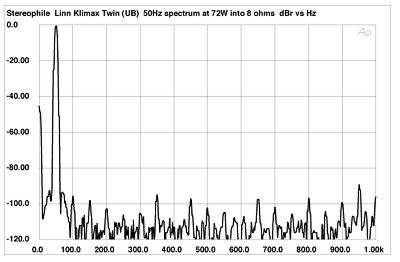
Fig.13 Linn Klimax Twin, unbalanced spectrum of 50Hz sinewave, DC-10kHz, at 72W into 8 ohms (linear frequency scale)..
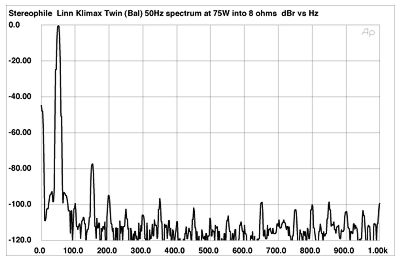
Fig.14 Linn Klimax Twin, balanced spectrum of 50Hz sinewave, DC-10kHz, at 75W into 8 ohms (linear frequency scale).
Fig.15 shows the spectrum of the Klimax Twin's output while it reproduced an equal mix of 19kHz and 20kHz tones just below the level at which this demanding signal could be seen to clip on the monitoring oscilloscope. The 1kHz difference product lies at a good -72dB (0.025%), and the Klimax Twin actually does better on this test than the Klimax 500 monoblock that Jonathan Scull reviewed in October 1999.
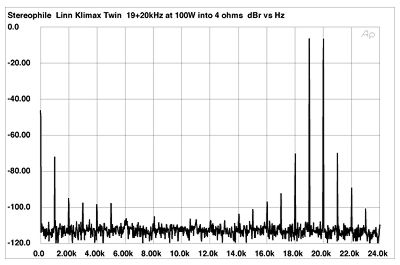
Fig.15 Linn Klimax Twin, HF intermodulation spectrum, DC-24kHz, 19+20kHz at 100W into 4 ohms (linear frequency scale).
Finally, while the Linn offers 110Wpc into 8 ohms (20.4dBW) at our usual 1% THD clipping point (fig.16), it doesn't quite meet its 230Wpc specification into 4 ohms, delivering 210W into that load (20.2dBW). The shortfall is trivial, but more important, the Klimax Twin emitted loud whirring sounds as it approached its limit with continuous drive into 4 and 2 ohms. Into the latter, it actually cut off before the actual clipping point was reached, suggesting that low impedances are best avoided. This would appear to disqualify the Klimax Twin for use with Linn's own state-of-the-art Komri loudspeaker, which dips well below 4 ohms in the high treble and the upper bass.
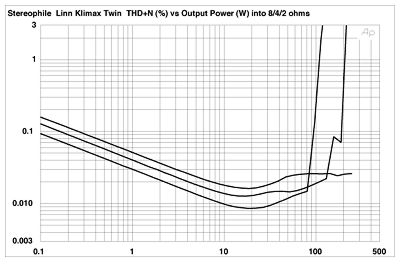
Fig.16 Linn Klimax Twin, distortion (%) vs 1kHz continuous output power into (from bottom to top): 8 ohms, 4 ohms, 2 ohms.
Other than its harmonic distortion spectrum—even though the harmonics are all extremely low in level, I would be more comfortable with fewer high-order components—the Linn Klimax Kontrol preamplifier is beyond reproach as far as its measured performance goes. The Klimax Twin is more idiosyncratic, however. But it is fair to note that, in his auditioning, Art Dudley found nothing that bothered him.—John Atkinson
- Log in or register to post comments




































